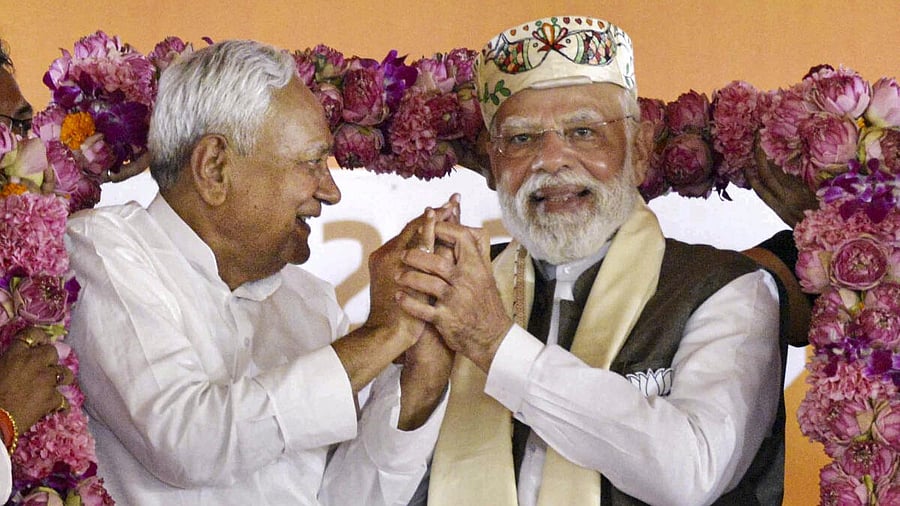
Prime Minister Narendra Modi and Bihar Chief Minister Nitish Kumar being garlanded during a public meeting ahead of the state Assembly elections, in Samastipur district.
Credit: PTI Photo
After Deepavali, as the Bihar election campaign enters its last leg, both the I.N.D.I.A. bloc and the NDA have doubled down on their campaign, taking the battle to the Opposition camp. Freebies and development promises notwithstanding, the broader theme of the election is veering towards caste and social faultlines, with both sides attempting to dig up the ghost of the past to resurrect the present narrative.
Top NDA leaders have sought to underscore the fear of ‘jungle raj’ during Lalu Yadav’s undisputed rule of the state between 1989 and 2005. The resurrection of the Lalu regime or the fear of it, should the RJD come to power, is a common refrain at BJP rallies.
Modi's 'lath' strike
In his first campaign rally, Prime Minister Narendra Modi called the Mahagathbandhan a ‘lath-bandhan’, an oblique reference to (lath) stick-wielding local strongmen during Lalu’s tenure, aimed at reminding the electorate of the post-Mandal Bihar in the nineties.
For those who have lived through that decade, the imagery may strike a chord. But for others born at the turn of the century, who have all their lives lived under Nitish Kumar’s rule, the Lalu Raj may get lost in the political construct of the self, especially among the aspirational class, in the digital age.
Which is precisely the reason why Modi, in an address to BJP workers last week, urged his cadre to tell people, especially youth and women, about people’s suffering during the RJD’s “jungle raj”.
Target audience
The target audience for the campaign can broadly be divided into two groups. One, the Hindu upper castes who shifted to the BJP after the Mandal-Kamandal disruption in 1989. The second, and the critical segment, that the BJP is trying to address is the non-Yadav backward caste that united under Nitish’s leadership to challenge and subsequently end Lalu’s rule.
To counter the BJP, the RJD has tried to turn the clock further back. Its strategy is an acknowledgement of Nitish’s unique positioning in the Bihar politics. In alliance with the RJD, he offers protection to numerically smaller yet cumulatively strong, extremely backward classes against Yadav domination. When he’s with the BJP, Nitish provides a similar buffer against an upper caste assertion.
When the RJD underscores the point in its rallies that Nitish’s position as chief minister remains uncertain after the elections, it is indirectly trying to trigger a larger backward-dalit mobilisation by alluding that the NDA’s victory would mean the return of upper-caste hegemony, a pre-Mandal situation of 1989.
CM messaging
This also explains why, after initial ambiguity, state BJP leaders like Deputy CM Samrat Chaudhary have had to come out with statements confirming that Nitish will remain Bihar CM after the elections.
In the end, the Bihar elections may go down to who can assuage the concern of the weaker sections and win their trust by convincing them that the deviations of the past would not be repeated. The outcome may depend on who the voters trust more. The political discourse is offering three choices: Nitish Raj, Lalu Raj and a pre-Mandal-Kamandal Raj.